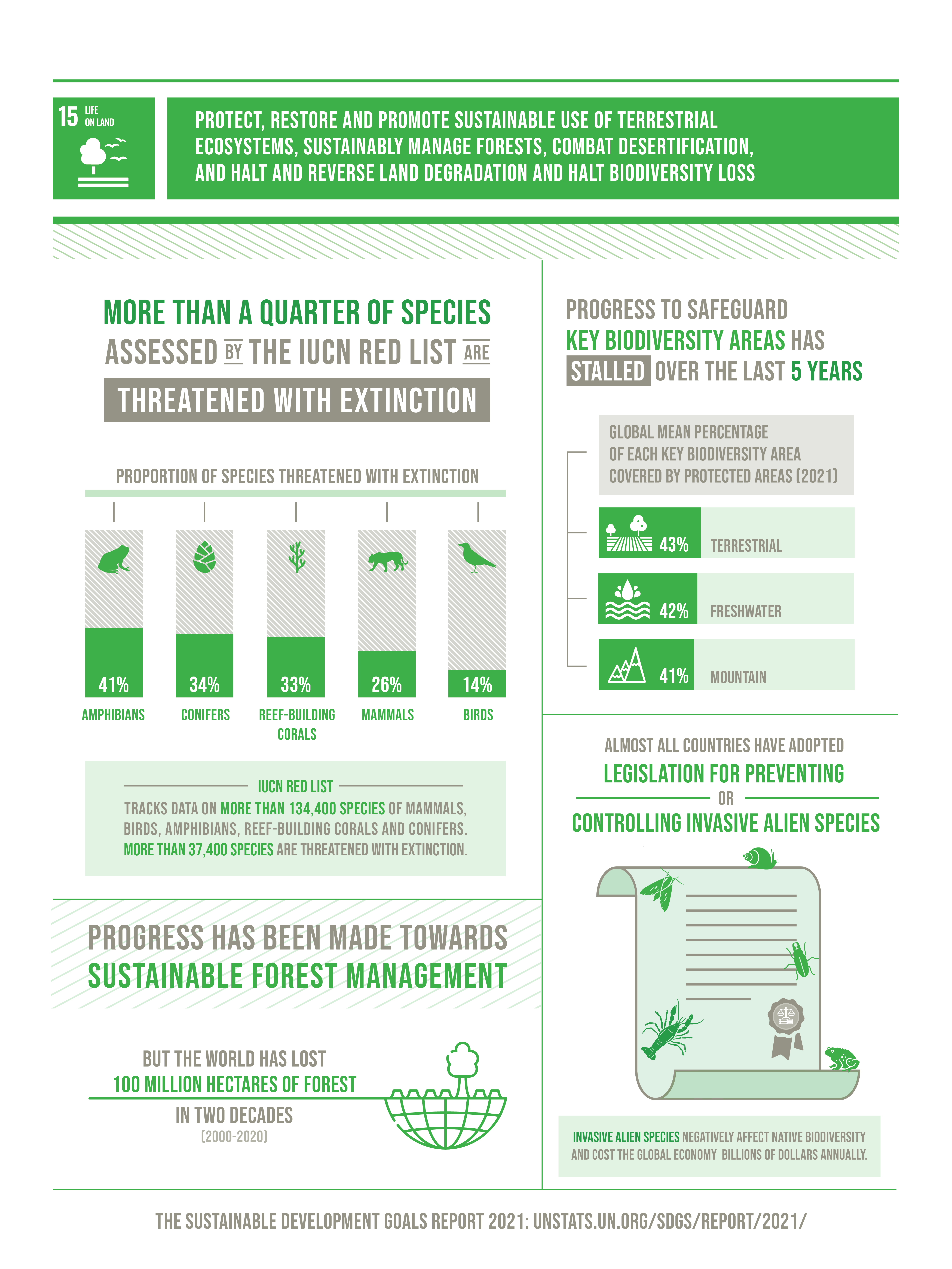



Around 1 million animal and plant species are threatened with extinction – many within decades – according to the 2019 Global Assessment Report on Biodiversity and Ecosystem Service. The report called for transformative changes to restore and protect nature. It found that the health of ecosystems on which we and all other species depend is deteriorating more rapidly than ever, affecting the very foundations of our economies, livelihoods, food security, health and quality of life worldwide.
Deforestation and desertification – caused by human activities and climate change – pose major challenges to sustainable development and have affected the lives and livelihoods of millions of people. Forests are vitally important for sustaining life on Earth, and play a major role in the fight against climate change. And investing in land restoration is critical for improving livelihoods, reducing vulnerabilities, and reducing risks for the economy.
The health of our planet also plays an important role in the emergence of zoonotic diseases, i.e. diseases that are transmissible between animals and humans. As we continue to encroach on fragile ecosystems, we bring humans into ever-greater contact with wildlife, enabling pathogens in wildlife to spill over to livestock and humans, increasing the risk of disease emergence and amplification.
A few facts and figures:
- Human activity has altered almost 75 per cent of the earth’s surface, squeezing wildlife and nature into an ever-smaller corner of the planet and increasing risks of zoonotic diseases like COVID-19.
Forests
- Around 1.6 billion people depend on forests for their livelihood, including 70 million indigenous people.
- Forests are home to more than 80 per cent of all terrestrial species of animals, plants and insects.
- Between 2010 and 2015, the world lost 3.3 million hectares of forest areas. Poor rural women depend on common pool resources and are especially affected by their depletion.
- Currently, land degradation has reduced productivity in 23 per cent of the global terrestrial area, and between $235 billion and $577 billion in annual global crop output is at risk as a result of pollinator loss.
Desertification
- Arable land loss is estimated at 30 to 35 times the historical rate
- Due to drought and desertification, 12 million hectares are lost each year (23 hectares per minute). Within one year, 20 million tons of grain could have been grown.
- 74 per cent of the poor are directly affected by land degradation globally.
- Habitat loss and deterioration, largely caused by human actions, have reduced global terrestrial habitat integrity by 30 per cent relative to an unimpacted baseline.
Biodiversity
- Illicit poaching and trafficking of wildlife continues to thwart conservation efforts, with nearly 7,000 species of animals and plants reported in illegal trade involving 120 countries.
- Of the 8,300 animal breeds known, 8 per cent are extinct and 22 per cent are at risk of extinction.
- Of the over 80,000 tree species, less than 1 per cent have been studied for potential use.
- Fish provide 20 per cent of animal protein to about 3 billion people. Only ten species provide about 30 per cent of marine capture fisheries and ten species provide about 50 per cent of aquaculture production.
- Over 80 per cent of the human diet is provided by plants. Only three cereal crops – rice, maize and wheat – provide 60 per cent of energy intake.
- As many as 80 per cent of people living in rural areas in developing countries rely on traditional plant-‐based medicines for basic healthcare.
- Micro-organisms and invertebrates are key to ecosystem services, but their contributions are still poorly known and rarely acknowledged.
- While protected areas now cover 15 per cent of terrestrial and freshwater environments and 7 per cent of the marine realm, they only partly cover important sites for biodiversity and are not yet fully ecologically representative and effectively or equitably managed.
15.1 By 2020, ensure the conservation, restoration and sustainable use of terrestrial and inland freshwater ecosystems and their services, in particular forests, wetlands, mountains and drylands, in line with obligations under international agreements
15.2 By 2020, promote the implementation of sustainable management of all types of forests, halt deforestation, restore degraded forests and substantially increase afforestation and reforestation globally
15.3 By 2030, combat desertification, restore degraded land and soil, including land affected by desertification, drought and floods, and strive to achieve a land degradation-neutral world
15.4 By 2030, ensure the conservation of mountain ecosystems, including their biodiversity, in order to enhance their capacity to provide benefits that are essential for sustainable development
15.5 Take urgent and significant action to reduce the degradation of natural habitats, halt the loss of biodiversity and, by 2020, protect and prevent the extinction of threatened species
15.6 Promote fair and equitable sharing of the benefits arising from the utilization of genetic resources and promote appropriate access to such resources, as internationally agreed
15.7 Take urgent action to end poaching and trafficking of protected species of flora and fauna and address both demand and supply of illegal wildlife products
15.8 By 2020, introduce measures to prevent the introduction and significantly reduce the impact of invasive alien species on land and water ecosystems and control or eradicate the priority species
15.9 By 2020, integrate ecosystem and biodiversity values into national and local planning, development processes, poverty reduction strategies and accounts
15.A Mobilize and significantly increase financial resources from all sources to conserve and sustainably use biodiversity and ecosystems
15.B Mobilize significant resources from all sources and at all levels to finance sustainable forest management and provide adequate incentives to developing countries to advance such management, including for conservation and reforestation
15.C Enhance global support for efforts to combat poaching and trafficking of protected species, including by increasing the capacity of local communities to pursue sustainable livelihood opportunities
Deforestation and forest degradation, continued biodiversity loss and the ongoing degradation of ecosystems are having profound consequences for human well-being and survival. The world fell short on 2020 targets to halt biodiversity loss. The COVID-19 pandemic has shown that, by threatening biodiversity, humanity threatens its own survival. While great efforts are being made to expand sustainable forest management, increase coverage of key biodiversity areas and sign up t o legislation and treaties for protecting biodiversity and ecosystems, much more needs to be done to put the health of the planet at the centre of all plans and policies.
While the rate of deforestation in tropical regions has slowed in the past decad e, vigilance and targeted efforts are required to maintain this trend. The proportion of forest area fell from 31.9 per cent of total land area in 2000 to 31.2 per cent in 2020, representing a net loss of almost 100 million hectares of the world’s forests. From 2000 to 2020, forest area increased in Asia, Europe and Northern America, but decreased significantly in Latin America and sub-Saharan Africa. Despite the losses in forest cover, above-ground forest biomass per hectare, the proportion of forest area in protected areas and under long-term management plans, and certified forest area all increased or remained stable at the global level and in most of the regions of the world, demonstrating global progress towards sustainable forest management.
In 2020, an average of 43 per cent of each terrestrial key biodiversity area, 42 per cent of each freshwater key biodiversity area, and 41 per cent of each mountain key biodiversity area were within protected areas, an increase of 13 to14 percentage points since 2000.
As of February 2021, 127 countries and territories had committed to setting voluntary targets for achieving land degradation neutrality, and 68 countries and territories had already officially endorsed their targets. Overall, commitments to la nd restoration are estimated to amount to 1 billion hectares, of which 450 million hectares are covered by commitments through land degradation neutrality targets.
Data based on satellite imagery reveal that green coverage (forests, grasslands, croplands and wetlands) of the world’s mountains remained steady at about 73 per cent between 2000 and 2018. Green cover tends to be greater in mountain areas that are less than 2,500 metres above sea level. However, mountain green cover varies considerably across geographical regions, ranging from 100 per cent in Oceania to 68 per cent in Northern Africa and Western Asia.
Globally, the risk of species extinction has increased by about 10 per cent over the past three decades. The Red List Index, which ranges from a value of 1 to indicate no risk of extinction to a value of 0 to indicate the extinction of all species, decreased from 0.81 in 1993 to 0.73 in 2021.
As at 1 February 2021, 128 countries, territories and the European Union had ratified the Nagoya Protocol on Access to Genetic Resources and the Fair and Equitable Sharing of Benefits Arising from their Utilization to the Convention on Biological Diversity, which is an increase of 60 countries and territories since 2016, and 67 countries, territories and the European Union have shared information on their Nagoya Protocol frameworks. There are now 148 parties to the International Treaty on Plant Genetic Resources for Food and Agriculture, and so far, 57 countries and territories have provided information about the measures that they have taken to implement the Nagoya Protocol.
The pandemic and the vast subsequent harm to human and economic well-being have starkly illustrated the potential global impact of zoonotic diseases, for which wildlife trade – both legal and illegal – is a potential vector. While certain markets for illegal wildlife products are declining, such as the market for ivory, which has decreased 3.5-fold since 2013, other species are under increasing threat as offenders shift their focus to more lucrative products, such as pangolin scales. In 2018, for example, there was a tenfold increase in the number of whole pangolin equivalents seized since 2014.
Nearly all countries and territories (98 per cent) have adopted national legislation for the prevention or control of invasive alien species, although there is wide variation in its coverage across sectors. The proportion of countries and territories aligning their targets for invasive alien species with global targets has increased, from 74 per cent in 2016 to 84 per cent in 2020.
As of March 2021, 89 countries and territories have implemented the system of environmental economic accounting, an increase of 29 per cent since 2017. Of these, 62 countries and territories (70 per cent) have integrated the system of accounting into their regular statistical production methods, and compile and publish the accounts on a regular basis.
In 2019, ODA from Development Assistance Committee members provided in support of biodiversity amounted to $6.6 billion, a decrease of 14 per cent in real terms compared to 2018. In 2021, a total of 232 biodiversity-relevant taxes are in force across 62 countries and territories.
Lost forests mean the disappearance of livelihoods in rural communities, increased carbon emissions, diminished biodiversity and the degradation of land. While forest loss remains high, 2020 data show that the proportion of forests in protected areas and under long-term management plans increased or remained stable at the global level and in most regions of the world. An irreversible effect of human activity on the environment is species extinction, which upsets the balance of nature and makes ecosystems more fragile and less resistant to disruptions. A recent UN report on biodiversity found that around 1 million animal and plant species are now threatened with extinction, many within decades, more than ever before in human history
Some things we can do to help include recycling, eating a locally-based diet that is sustainably sourced, and consuming only what we need. We must be respectful toward wildlife and only take part in ecotourism opportunities that are responsibly and ethically run in order to prevent wildlife disturbance. Well managed protected areas support healthy ecosystems, which in turn keep people healthy. It is therefore critical to secure the involvement of the local communities in the development and management of these protected areas.
Source:- www.un.org